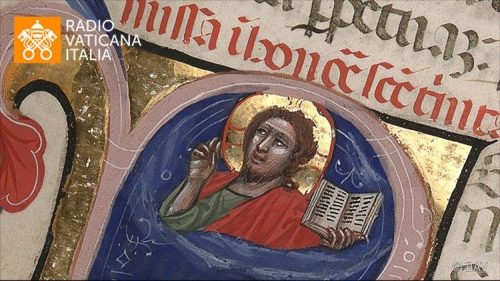READING OF THE DAY
A Reading from le Letter to the Hebrews
HEB 12:1-4
Brothers and sisters:
Since we are surrounded by so great a cloud of witnesses,
let us rid ourselves of every burden and sin that clings to us
and persevere in running the race that lies before us
while keeping our eyes fixed on Jesus,
the leader and perfecter of faith.
For the sake of the joy that lay before him
Jesus endured the cross, despising its shame,
and has taken his seat at the right of the throne of God.
Consider how he endured such opposition from sinners,
in order that you may not grow weary and lose heart.
In your struggle against sin
you have not yet resisted to the point of shedding blood.
GOSPEL OF THE DAY
From the Gospel according to Mark
MK 5:21-43
When Jesus had crossed again in the boat to the other side,
a large crowd gathered around him, and he stayed close to the sea.
One of the synagogue officials, named Jairus, came forward.
Seeing him he fell at his feet and pleaded earnestly with him, saying,
“My daughter is at the point of death.
Please, come lay your hands on her
that she may get well and live.”
He went off with him
and a large crowd followed him.
There was a woman afflicted with hemorrhages for twelve years.
She had suffered greatly at the hands of many doctors
and had spent all that she had.
Yet she was not helped but only grew worse.
She had heard about Jesus and came up behind him in the crowd
and touched his cloak.
She said, “If I but touch his clothes, I shall be cured.”
Immediately her flow of blood dried up.
She felt in her body that she was healed of her affliction.
Jesus, aware at once that power had gone out from him,
turned around in the crowd and asked, “Who has touched my clothes?”
But his disciples said to him,
“You see how the crowd is pressing upon you,
and yet you ask, Who touched me?”
And he looked around to see who had done it.
The woman, realizing what had happened to her,
approached in fear and trembling.
She fell down before Jesus and told him the whole truth.
He said to her, “Daughter, your faith has saved you.
Go in peace and be cured of your affliction.”
While he was still speaking,
people from the synagogue official’s house arrived and said,
“Your daughter has died; why trouble the teacher any longer?”
Disregarding the message that was reported,
Jesus said to the synagogue official,
“Do not be afraid; just have faith.”
He did not allow anyone to accompany him inside
except Peter, James, and John, the brother of James.
When they arrived at the house of the synagogue official,
he caught sight of a commotion,
people weeping and wailing loudly.
So he went in and said to them,
“Why this commotion and weeping?
The child is not dead but asleep.”
And they ridiculed him.
Then he put them all out.
He took along the child’s father and mother
and those who were with him
and entered the room where the child was.
He took the child by the hand and said to her, “Talitha koum,”
which means, “Little girl, I say to you, arise!”
The girl, a child of twelve, arose immediately and walked around.
At that they were utterly astounded.
He gave strict orders that no one should know this
and said that she should be given something to eat.
WORDS OF THE HOLY FATHER
Dear Brothers and Sisters, Good morning!
This […] Gospel passage (cf. Mk 5:21-43) presents two miracles performed by Jesus, almost describing them as a type of triumphal march toward life. Initially the Evangelist speaks about a certain Jairus, one of the rulers of the Synagogue, who approaches Jesus and beseeches Him to go to his home because his 12-year-old daughter is dying. Jesus agrees and goes with him; but, along the way, word arrives that the girl is dead. We can imagine that father’s reaction. But Jesus says to him: “Do not fear, only believe” (36). When they arrive at Jairus’ house, Jesus sends out the people who were weeping — there were also women mourners who were wailing loudly — and He enters the room with just the parents and the three disciples, and speaking to the dead girl He says: “Little girl, I say to you, arise” (v. 41). And immediately the girl gets up, as if waking from a deep sleep (cf. v. 42).
Within the narrative of this miracle, Mark adds another: the healing of a woman who suffers from a haemorrhage and is healed as soon as she touches Jesus’ garment (cf. v. 27). Here what is striking is the fact that this woman’s faith attracts — to me the word “robs” comes to mind — the divine saving power that is in Christ, who, feeling that “power had gone forth from him”, tried to understand who it was. And when the woman, with much shame, comes forward and confesses the whole truth, He tells her: “Daughter, your faith has made you well” (v. 34).
It is a matter of two interlocking narratives, with a single core: faith; and they show Jesus as the wellspring of life, as the One who restores life to those who trust fully in him. The two protagonists, that is, the little girl’s father and the sick woman, are not disciples of Jesus yet they are satisfied through their faith. They have faith in that man. From this we understand that all are permitted on the Lord’s path: no one should feel as an intruder, an interloper or one who has no right. To have access to His heart, to Jesus’ heart, there is only one requirement: to feel in need of healing and to entrust yourself to Him. I ask you: do each of you feel that you need to be healed? Of something, of some sin, of some problem? And, if you feel this, do you have faith in Jesus? These are the two requirements in order to be healed, in order to have access to his heart: to feel in need of healing and to entrust yourself to Him. Jesus goes to discover these people among the crowd and removes them from anonymity, frees them from the fear of living and of taking risks. He does so with a look and a word which sets them back on the path after much suffering and humiliation. We too are called to learn and to imitate these freeing words and this gaze which restores the will to live to those who lack it.
In this Gospel passage the themes of faith and of new life, which Jesus came to offer to all, are intertwined. When he enters the house where the dead girl lies, he sends outside those who are weeping and making tumult (cf. v. 40), and he says: “The child is not dead but sleeping” (v. 39). Jesus is Lord, and before him physical death is like a dream: there is no reason to despair. Another death is the one to fear: that of the heart hardened by evil! Yes, we should be afraid of that one! When we feel we have a hardened heart, a heart that is hardened, allow me to say, a mummified heart, we should be afraid of this. This is the death of the heart. But sin too, the mummified heart too, is never the last word with Jesus, because he has brought us the infinite mercy of the Father. And even if we have hit rock bottom, his tender and strong voice reaches us: “I say to you, arise!”. It is beautiful to hear that word of Jesus addressed to each one of us: “I say to you, arise! Go. Stand up. Take courage, arise!”. Jesus restores life to the little girl and restores life to the healed woman: life and faith to both.
Let us ask the Virgin Mary to accompany our journey of faith and of concrete love, especially toward those who are in need. Let us invoke her maternal intercession for our brothers and sisters who are suffering in body and in spirit.
(Angelus, 1 July 2018)

